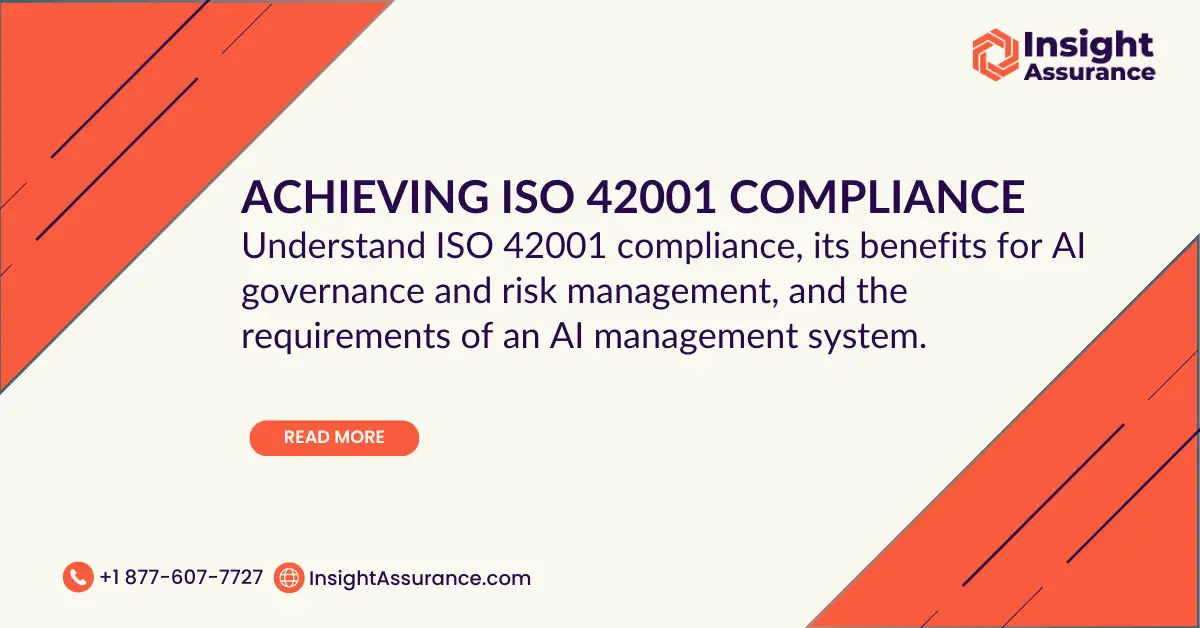Artificial intelligence (AI) is no longer experimental; it’s woven into fraud detection, customer service chatbots, generative design tools, and countless other business processes. As adoption accelerates, so do concerns about biased models, opaque decision-making, and data protection failures that can erode customer trust and invite regulatory scrutiny.
ISO/IEC 42001 answers these concerns as the world’s first certifiable AI management system standard. By offering a structured approach to AI governance, risk management, and continual improvement, the standard helps organizations demonstrate responsible AI practices, align with evolving regulations, and safeguard information security.
This guide explains what the ISO/IEC 42001 standard entails, how its clauses map to day-to-day AI operations, and where it sits alongside similar frameworks. It also highlights common implementation pitfalls and provides practical steps to help organizations achieve and maintain ISO 42001 compliance.
Understanding ISO/IEC 42001
ISO/IEC 42001:2023 is the first international standard specifically designed for governing artificial intelligence. Jointly published by the International Organization for Standardization (ISO) and the International Electrotechnical Commission (IEC), the document lays out a certifiable framework — an AI management system (AIMS) — that helps organizations oversee AI development, deployment, and continual improvement.
The standard emerged because existing security frameworks, such as ISO 27001, cover information security but overlook AI-specific issues, such as:
- Model bias: When training data or algorithms produce unfair or discriminatory outcomes, leading to ethical concerns and regulatory exposure.
- Data drift: When changes in input data over time degrade model accuracy or reliability, often without immediate detection.
- Algorithmic transparency: The challenge of explaining how complex AI models make decisions, especially in high-stakes use cases like finance or healthcare.
Regulators worldwide are closing this gap: the EU AI Act introduces risk-tiered obligations, while jurisdictions from Canada to Singapore are drafting similar rules. ISO 42001 offers a proactive path to responsible AI governance, giving businesses a clear structure that aligns with these emerging requirements rather than reacting piecemeal to each new law.
Who Is Subject to ISO/IEC 42001?
ISO/IEC 42001 applies broadly. According to the International Organization for Standardization, it’s relevant to businesses of any size or industry, including public sector agencies. By design, ISO/IEC 42001 is applicable across all AI systems, applications, and use cases. In short, any organization developing, deploying, or operating artificial intelligence falls within its scope.
What Is an Artificial Intelligence Management System?
An AIMS mirrors the high-level structure of other ISO management systems. Much like ISO/IEC 9001 for quality or ISO/IEC 27001 for information security, an AIMS embeds policies, roles, controls, and continual-improvement loops into everyday workflows. This familiarity lets teams integrate AI governance with existing processes rather than reinventing the wheel.
What Are the Benefits of ISO/IEC 42001 Compliance?
Achieving ISO/IEC 42001 certification can be highly advantageous. Organizations that successfully implement the framework can benefit from:
- Building stakeholder trust by demonstrating responsible AI practices and transparent decision-making.
- Aligning with future AI regulations, reducing last-minute compliance sprints.
- Improving AI risk management and overall governance, addressing issues such as model drift and bias.
- Enabling clear internal accountability through defined roles, metrics, and documented controls.
- Fostering continuous improvement as AI objectives, risks, and technologies evolve.
With the why and who established, the next step is understanding how the standard is structured.
Inside the ISO/IEC 42001 Framework: Clauses 4–10
ISO/IEC 42001 adopts the Annex SL structure used by ISO/IEC 27001, ISO 9001, and other widely recognized management system standards. This harmonized format lets organizations layer an AIMS onto existing information security or quality programs without duplicating effort.
The first three clauses — scope, normative references, and terms — set context and definitions. They do not introduce requirements but provide the foundation needed to implement Clauses 4–10, where the actionable ISO 42001 requirements reside.
Clause 4: Context of the Organization
Every AI provider must define the boundaries of its AIMS, identify internal and external stakeholders, and analyze issues such as market expectations, regulatory requirements, and technological dependencies. A clear scope prevents both over-engineering and blind spots, ensuring that generative AI prototypes, deployed chatbots, and machine-learning pipelines receive proportionate oversight.
Clause 5: Leadership
Top management steers the AIMS by establishing an AI policy, assigning roles, and communicating the organization’s commitment to ethical, transparent, and lawful AI use. Their visible sponsorship secures budget, aligns cross-functional teams, and embeds responsible AI practices into strategic objectives rather than leaving them to isolated data-science groups.
Clause 6: Planning
Risk-based thinking drives this clause. Teams conduct AI risk assessments to pinpoint bias, model drift, or privacy concerns, then set measurable AI objectives — such as reducing false-positive rates or improving explainability scores — and plan changes to reach them. Effective planning links AI performance targets to broader compliance and data-protection goals.
Clause 7: Support
An AIMS cannot function without resources. Organizations must allocate skilled personnel, suitable tooling, and documented information — from model cards to version-controlled training data — to keep AI operations auditable and secure. Targeted training ensures developers, product owners, and legal teams understand their responsibilities under ISO/IEC 42001 compliance.
Clause 8: Operation
This clause turns plans into action. It requires documented processes and controls that span the AI lifecycle: design, data acquisition, testing, deployment, monitoring, and retirement. Activities include secure coding, bias checks, penetration testing of AI endpoints, and formal change management to protect AI security and performance in production.
Clause 9: Performance Evaluation
Organizations must monitor AI objectives, run internal audits, and hold management reviews. Metrics such as model accuracy, fairness scores, and incident response times feed continuous insight into whether AI risk management remains effective and aligned with business needs.
Clause 10: Improvement
Nonconformities — whether a drifted model or a failed explainability test — trigger corrective actions and lessons learned. The clause mandates continual improvement so the AIMS evolves alongside emerging regulations, new AI standards, and shifting stakeholder expectations.
ISO/IEC 42001 vs. Other AI Frameworks
The landscape of AI governance includes a mix of voluntary guidelines, regulatory statutes, and industry standards. Understanding how ISO/IEC 42001 compares with the most prominent risk management frameworks helps organizations choose complementary approaches rather than duplicating effort.
NIST AI Risk Management Framework (RMF)
The NIST AI RMF is a voluntary U.S. guide that promotes trustworthy AI outcomes through functions such as:
- Map: Identify AI-related risks by evaluating the system’s context, intended use, and potential consequences.
- Measure: Analyze and evaluate those risks using both qualitative insights and quantitative data.
- Manage: Address and prioritize risks by implementing appropriate mitigation tactics and safeguards.
- Govern: Define clear policies, processes, and governance structures to ensure consistent oversight of AI risk management efforts.
It offers practical risk-mitigation tactics but does not provide a certifiable pathway, leaving assurance gaps when customers or regulators request formal proof of compliance.
The EU AI Act
The EU AI Act adopts a mandatory, risk-tiered model for any organization that markets or operates AI systems within the European Union. High-risk applications — such as credit scoring or critical infrastructure — must meet strict obligations around data quality, transparency, and human oversight, while prohibited uses face outright bans. Compliance is essential for market access, but the Act focuses on legal requirements rather than internal management-system structures.
Organization for Economic Cooperation and Development (OECD) AI Principles
The OECD AI Principles supply high-level ethical guidance — fairness, robustness, transparency — but stop short of operational instructions. They’re valuable for shaping corporate values, yet organizations still need concrete mechanisms to embed those principles into day-to-day AI development and deployment.
ISO/IEC 27001
ISO/IEC 27001 remains the benchmark for information security management systems, covering threats to confidentiality, integrity, and availability. However, its controls don’t specifically address AI-centric issues such as model bias, explainability, or performance drift, creating blind spots when machine-learning pipelines form the backbone of business services.
Key differences to keep in mind:
- ISO/IEC 42001 is certifiable, giving organizations a recognized credential for responsible AI practices.
- It is built for lifecycle AI risk and governance, addressing design, deployment, and retirement.
- The standard integrates ethical and transparency goals directly into a management system structure, ensuring they’re measurable and auditable.
- Unlike the NIST AI RMF and OECD Principles, ISO/IEC 42001 enables third-party validation, and it dovetails with existing ISO standards, simplifying integration with ISO/IEC 27001 or ISO/IEC 9001 programs.
With the comparative landscape clarified, the next logical step is to explore common pitfalls that organizations encounter when implementing ISO/IEC 42001 and how to avoid them.
Common Pitfalls in ISO/IEC 42001 Implementation
1. Improperly Scoping AI Systems
Misidentifying AI systems is a frequent stumbling block. Over-scoping can flood teams with low-risk chatbots that distract from mission-critical models, while under-scoping leaves generative AI engines or autonomous decision tools outside the Artificial Intelligence Management System and jeopardizes ISO/IEC 42001 compliance. A thorough AI risk assessment during scoping ensures the AIMS covers every high-impact AI application without diluting resources.
2. Treating AIMS as a Siloed Initiative
Approaching the AIMS as a siloed IT or compliance project undermines its effectiveness. When data scientists view governance as an external checkpoint rather than an integral part of AI development, critical controls become afterthoughts, and corrective actions arrive too late to influence model design. Embedding ISO/IEC 42001 requirements into agile workflows keeps responsible AI practices visible from ideation through deployment.
3. Lack of Integration With Other Systems or Frameworks
Failure to align the AIMS with existing management systems — particularly an ISO/IEC 27001 information security management system — creates unnecessary duplication. Overlapping policies, fragmented audit trails, and conflicting change-management processes waste resources and frustrate stakeholders. Harmonizing documentation and leveraging shared controls accelerates certification and streamlines ongoing AI operations.
4. Overlooking AI Risks
Organizations often overlook AI-specific risks such as model drift, bias, or explainability gaps. Traditional penetration testing cannot detect when a predictive model slowly skews results, and standard data-protection controls may miss the ethical hazards of biased outputs. Building continuous monitoring, fairness metrics, and retraining protocols into Clause 8 operational controls addresses these unique AI threats.
5. Lack of Cross-Functional Alignment
Misalignment across legal, risk, data science, and product teams can stall progress. ISO/IEC 42001 requires cross-functional ownership, yet conflicting priorities or unclear roles delay decisions on AI governance. Creating an AI risk council and integrating responsibilities into performance objectives keeps everyone accountable for responsible AI practices.
6, Poor Documentation
Inadequate documentation or version control is another common pitfall. Without granular records of training data, model versions, and configuration changes, audit readiness suffers, and root-cause analysis becomes guesswork. Robust documentation platforms and automated model registries preserve evidence for external auditors and support continual improvement.
Prepare Your Organization for ISO/IEC 42001 Compliance
Proactive AI governance isn’t just a best practice — it’s quickly becoming a baseline expectation from regulators, customers, and investors. Implementing an Artificial Intelligence Management System before external mandates take effect gives organizations room to refine processes, demonstrate due diligence, and protect their reputation when AI systems scale or pivot into new markets.
ISO/IEC 42001 provides the structured pathway needed to embed responsible AI practices at scale. By integrating ethical principles, lifecycle risk management, and continual improvement into everyday workflows, the standard helps teams maintain AI performance, security, and transparency even as models evolve or data sources expand. Early adopters gain a competitive edge, showcasing verifiable compliance when bidding for contracts, entering new jurisdictions, or seeking investment.
Getting started is simpler when organizations synchronize ISO/IEC 42001 with existing ISO/IEC 27001 or quality programs, conduct a gap analysis against current AI operations, and form cross-functional governance groups to champion responsible AI objectives. Investing now in documented processes, robust monitoring, and targeted training minimizes future compliance costs and shortens the certification timeline.
Need guidance navigating the complexities of ISO/IEC 42001 certification for your AI management systems? Contact Insight Assurance and access our expert assessment services today.


